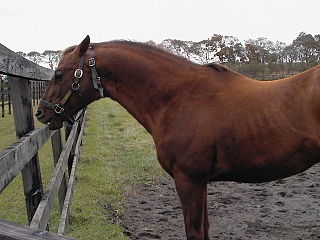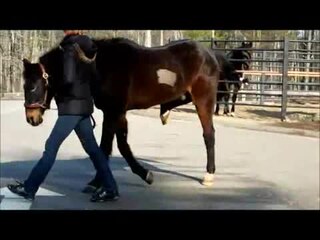Related Research Articles

Rhabdomyolysis is a condition in which damaged skeletal muscle breaks down rapidly. Symptoms may include muscle pains, weakness, vomiting, and confusion. There may be tea-colored urine or an irregular heartbeat. Some of the muscle breakdown products, such as the protein myoglobin, are harmful to the kidneys and can cause acute kidney injury.
Locoweed is a common name in North America for any plant that produces swainsonine, a alkaloid harmful to livestock. Worldwide, swainsonine is produced by a small number of species, most of them in three genera of the flowering plant family Fabaceae: Oxytropis and Astragalus in North America, and Swainsona in Australia. The term locoweed usually refers only to the North American species of Oxytropis and Astragalus, but this article includes the other species as well. Some references may incorrectly list Datura as locoweed.
In medicine, myopathy is a disease of the muscle in which the muscle fibers do not function properly. This results in muscular weakness. Myopathy means muscle disease. This meaning implies that the primary defect is within the muscle, as opposed to the nerves or elsewhere. Muscle cramps, stiffness, and spasm can also be associated with myopathy.

Laminitis is a disease that affects the feet of ungulates and is found mostly in horses and cattle. Clinical signs include foot tenderness progressing to inability to walk, increased digital pulses, and increased temperature in the hooves. Severe cases with outwardly visible clinical signs are known by the colloquial term founder, and progression of the disease will lead to perforation of the coffin bone through the sole of the hoof or being unable to stand up, requiring euthanasia.
An enterolith is a mineral concretion or calculus formed anywhere in the gastrointestinal system. Enteroliths are uncommon and usually incidental findings but, once found, they require at a minimum watchful waiting. If there is evidence of complications, they must be removed. An enterolith may form around a nidus, a small foreign object such as a seed, pebble, or piece of twine that serves as an irritant. In this respect, an enterolith forms by a process similar to the creation of a pearl. An enterolith is not to be confused with a gastrolith, which helps digestion.

Cribbing is a form of stereotypy (equine oral stereotypic behaviour), otherwise known as wind sucking or crib-biting. Cribbing is considered to be an abnormal, compulsive behavior seen in some horses, and is often labelled a stable vice. The major factors that cause cribbing include stress, stable management, genetic and gastrointestinal irritability.

Hypoglycin A is a naturally occurring amino acid derivative found in the unripened fruit of the Ackee tree and in the seeds of the box elder tree. It is toxic if ingested, and is the causative agent of Jamaican vomiting sickness. A 2017 Lancet report established a link between the consumption of unripened lychees resulting in hypoglycaemia and death from acute toxic encephalopathy.
Exercise-induced pulmonary hemorrhage (EIPH), also known as "bleeding" or a "bleeding attack", refers to the presence of blood in the airways of the lung in association with exercise. EIPH is common in horses undertaking intense exercise, but it has also been reported in human athletes, racing camels and racing greyhounds. Horses that experience EIPH may also be referred to as "bleeders" or as having "broken a blood vessel". In the majority of cases, EIPH is not apparent unless an endoscopic examination of the airways is performed following exercise. This is distinguished from other forms of bleeding from the nostrils, called epistaxis.
Grass sickness, alternatively termed equine dysautonomia, is a rare but predominantly fatal illness in horses. Grass sickness may affect all types of horse, pony and donkey, and has affected some well known horses including the thoroughbred stallions Dubai Millennium, Moorestyle and Mister Baileys.
Equine polysaccharide storage myopathy is a hereditary glycogen storage disease of horses that causes exertional rhabdomyolysis. It is currently known to affect the following breeds American Quarter Horses, American Paint Horses, Warmbloods, Cobs, Dales Ponies, Thoroughbreds, Arabians, New Forest ponies, and a large number of Heavy horse breeds. While incurable, PSSM can be managed with appropriate diet and exercise. There are currently 2 subtypes, known as Type 1 PSSM and Type 2 PSSM.
Fog fever is a refeeding syndrome in cattle, clinically named acute bovine pulmonary emphysema and edema (ABPEE) and bovine atypical interstitial pneumonia. This veterinary disease in adult cattle follows an abrupt move from feedlot to 'foggage pasture'. Clinical signs begin within 1 to 14 days and death may follow within 2 to 4 days. The condition can affect up to 50% of the herd, and around 30% of affected cattle may die as a result. This metabolic nutritional-respiratory disturbance has also been reported in other ruminants and on a wide variety of grasses, alfalfa, rape, kale, and turnip tops.

Equine metabolic syndrome (EMS) is an endocrinopathy affecting horses and ponies. It is of primary concern due to its link to obesity, insulin dysregulation, and subsequent laminitis. There are some similarities in clinical signs between EMS and pituitary pars intermedia dysfunction, also known as PPID or Cushing's disease, and some equines may develop both, but they are not the same condition, having different causes and different treatment.

Tiludronic acid is a bisphosphonate used for treatment of Paget's disease of bone in human being medicine. It has the tradename Skelid. In veterinary medicine, tiludronic acid is used to treat navicular disease and bone spavin in horses. Its tradenames are Tildren and Equidronate. It is approved for treatment of navicular disease and distal, tarsal osteoarthritis in Europe, and was approved for treatment of navicular disease in the United States in 2014.

Stringhalt is a sudden flexion of one or both hind legs in the horse, most easily seen while the horse is walking or trotting. It is most evident when the horse is backing up slowly, turning on the affected leg, or suddenly frightened. It can involve one or both hind legs of the horse. It is a spasmodic contraction of the lateral extensor tendons of the hind legs.

Lavender foal syndrome (LFS), also called coat color dilution lethal (CCDL), is an autosomal recessive genetic disease that affects newborn foals of certain Arabian horse bloodlines. Affected LFS foals have severe neurological abnormalities, cannot stand, and require euthanasia shortly after birth. The popular name originates due to a diluted color of the foal's coat, that in some cases appears to have a purple or lavender hue. However, not all foals possess the lavender coat colour, and colouring can range from silver to light chestnut to a pale pink. Carrier horses have no clinical signs and DNA testing can determine if a horse carries the gene.
Lameness is an abnormal gait or stance of an animal that is the result of dysfunction of the locomotor system. In the horse, it is most commonly caused by pain, but can be due to neurologic or mechanical dysfunction. Lameness is a common veterinary problem in racehorses, sport horses, and pleasure horses. It is one of the most costly health problems for the equine industry, both monetarily for the cost of diagnosis and treatment, and for the cost of time off resulting in loss-of-use.

Guttural pouches are large, auditory-tube diverticula that contain between 300 and 600 ml of air. They are present in odd-toed mammals, some bats, hyraxes, and the American forest mouse. They are paired bilaterally just below the ears, behind the skull and connect to the nasopharynx.
Shivers, or equine shivering, is a rare, progressive neuromuscular disorder of horses. It is characterized by muscle tremors, difficulty holding up the hind limbs, and an unusual gait when the horse is asked to move backwards. Shivers is poorly understood and no effective treatment is available at this time.
Perennial ryegrass staggers is poisoning by peramine, lolitrem B, and other toxins that are contained in perennial ryegrass, and produced by the endophyte fungus Neotyphodium lolii which can be present in all parts of the grass plant, but tends to be concentrated in the lower part of the leaf sheaths, the flower stalks and seeds. This condition can affect horses, cattle, sheep, farmed deer and llamas. It regularly occurs in New Zealand and is known spasmodically from Australia, North and South America, and Europe.
Nigropallidal encephalomalacia or Chewing disease is a neurological condition that affects horses that have eaten certain toxic plants. Affected animals are unable to prehend food because of lip and tongue paralysis, and may appear to keep their jaws open with the tongue protruded because of reduced jaw tone. Some horses may appear to show their upper teeth because of increased hypertonicity of the facial and upper lip muscles. Other animals may show severe depression and carrying their heads low. Because poisoned horses are unable to eat, these animals become weakened and ultimately die of starvation.
References
- 1 2 3 4 5 6 7 Votion DM, Serteyn D (November 2008). "Equine atypical myopathy: a review". Veterinary Journal. 178 (2): 185–90. doi:10.1016/j.tvjl.2008.02.004. PMID 18375157.
- ↑ Votion D (April 2010). "La myopathie atypique des équidés" (PDF). Archived from the original (PDF) on 2014-02-22.
- 1 2 3 Van Galen G, Amory H, Busschers E, Cassart D, De Bruijn M, Gerber V, et al. (October 2010). "European outbreak of atypical myopathy in the autumn 2009". Journal of Veterinary Emergency and Critical Care. 20 (5): 528–32. doi: 10.1111/j.1476-4431.2010.00574.x . PMID 20955305.
- 1 2 González Medina S, Hyde C, Lovera I, Piercy RJ (2018-07-03). "Detection of equine atypical myopathy-associated hypoglycin A in plant material: Optimisation and validation of a novel LC-MS based method without derivatisation". PLOS ONE. 13 (7): e0199521. Bibcode:2018PLoSO..1399521G. doi: 10.1371/journal.pone.0199521 . PMC 6029767 . PMID 29969503.
- 1 2 Karlíková R, Široká J, Jahn P, Friedecký D, Gardlo A, Janečková H, et al. (October 2016). "Equine atypical myopathy: A metabolic study". Veterinary Journal. 216: 125–32. doi:10.1016/j.tvjl.2016.07.015. PMID 27687939.
- 1 2 "Equine Atypical Myopathy Testing". Royal Veterinary College. 2017. Retrieved 2019-12-08.
- ↑ Żuraw A, Dietert K, Kühnel S, Sander J, Klopfleisch R (July 2016). "Equine atypical myopathy caused by hypoglycin A intoxication associated with ingestion of sycamore maple tree seeds". Equine Veterinary Journal. 48 (4): 418–21. doi:10.1111/evj.12460. PMID 25970235.
- ↑ Votion DM, van Galen G, Sweetman L, Boemer F, de Tullio P, Dopagne C, et al. (March 2014). "Identification of methylenecyclopropyl acetic acid in serum of European horses with atypical myopathy". Equine Veterinary Journal. 46 (2): 146–9. doi:10.1111/evj.12117. PMID 23773055.
- 1 2 3 4 5 6 7 8 "Atypical myopathy (Sycamore poisoning)" (PDF). B&W Equine Vets.
- 1 2 Boemer F, Detilleux J, Cello C, Amory H, Marcillaud-Pitel C, Richard E, et al. (August 2017). "Acylcarnitines profile best predicts survival in horses with atypical myopathy". PLOS ONE. 12 (8): e0182761. Bibcode:2017PLoSO..1282761B. doi: 10.1371/journal.pone.0182761 . PMC 5573150 . PMID 28846683.
- ↑ Bochnia M, Ziegler J, Sander J, Uhlig A, Schaefer S, Vollstedt S, et al. (2015). "Hypoglycin A Content in Blood and Urine Discriminates Horses with Atypical Myopathy from Clinically Normal Horses Grazing on the Same Pasture". PLOS ONE. 10 (9): e0136785. Bibcode:2015PLoSO..1036785B. doi: 10.1371/journal.pone.0136785 . PMC 4574941 . PMID 26378918.
- ↑ Lemieux H, Boemer F, van Galen G, Serteyn D, Amory H, Baise E, et al. (September 2016). "Mitochondrial function is altered in horse atypical myopathy". Mitochondrion. 30: 35–41. doi:10.1016/j.mito.2016.06.005. hdl: 1854/LU-8507237 . PMID 27374763.
- 1 2 McKenzie RK, Hill FI, Habyarimana JA, Boemer F, Votion DM (May 2016). "Detection of hypoglycin A in the seeds of sycamore (Acer pseudoplatanus) and box elder (A. negundo) in New Zealand; the toxin associated with cases of equine atypical myopathy". New Zealand Veterinary Journal. 64 (3): 182–7. doi:10.1080/00480169.2015.1123123. PMID 26593855. S2CID 8237904.
- ↑ Votion D, van Galen G, Marr CM (November 2009). "Equine atypical myopathy". The Veterinary Record. 165 (20): 605. doi:10.1136/vr.165.20.605-b. PMID 19915196. S2CID 30893301.
- ↑ Votion DM (2018-01-01). "Analysing hypoglycin A, methylenecyclopropylacetic acid conjugates and acylcarnitines in blood to confirm the diagnosis and improve our understanding of atypical myopathy". Equine Veterinary Education. 30 (1): 29–30. doi:10.1111/eve.12617.
- ↑ Gonzalez-Medina S (February 2015). "Update on the cause of equine atypical myopathy". The Veterinary Record. 176 (6): 143–5. doi:10.1136/vr.h414. PMID 25655543. S2CID 5455536.
- ↑ Votion DM (November 2012). "The story of equine atypical myopathy: a review from the beginning to a possible end". ISRN Veterinary Science. 2012: 281018. doi: 10.5402/2012/281018 . PMC 3671727 . PMID 23762581.
- ↑ Fabius LS, Westermann CM (2018). "Evidence-based therapy for atypical myopathy in horses". Equine Veterinary Education. 30 (11): 616–622. doi:10.1111/eve.12734. ISSN 2042-3292. S2CID 79038752.